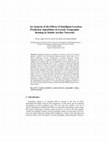Papers by S. Moffett
4th MIC Conference 2020 – Virtual Edition, Jun 16, 2020
Journal of Knowledge Management, 2012
Purpose – The majority of knowledge management theory and practice literature is based on, and re... more Purpose – The majority of knowledge management theory and practice literature is based on, and relates to, western and Japanese business environments and related assumptions. A number of generic knowledge management cross sectional studies based on Chinese organizations have taken place; however there is a lack of in-depth critical studies which are culturally grounded and which focus on a particular

Geographic routing uses the physical locations of devices for routing purposes instead of the con... more Geographic routing uses the physical locations of devices for routing purposes instead of the conventional routing protocols which make use of logical addressing schemes representing an abstract hierarchy. Greedy geographic routing is a popular method favoured for its efficiency and its simplicity that considers only one hop neighbours. Greedy routing needs only minimal network information and as such is resilient to change and dynamic behaviour. Recent advances have seen the development of location prediction algorithms that use a variety of methods to determine a node's future location based on their previous movements. Such prediction schemes can potentially benefit greedy geographic routing by allowing nodes to make routing decisions based on where a node will go rather than where it was according to the last update. The use of location prediction algorithms therefore allows geographic routing protocols to make decisions that are more intelligent, thus not only improving routing performance but providing a crucial step towards fully autonomous computer communications. The main contribution of this paper is the implementation and analysis of two existing location prediction schemes on top of the existing Greedy Perimeter Stateless Routing (GPSR) protocol ran in greedy mode.

BAM2018 Conference Proceedings, 2018
A number of studies argue that organisational performance can be enhanced due to
employee’s crea... more A number of studies argue that organisational performance can be enhanced due to
employee’s creativity (Buhl et al., 2016; Mihail and Kloutsiniotis, 2016; Chowhan et al.,
2017). Although the problem of individual creativity at work has received significant
attention (Doran and Ryan, 2017; Fortwengel et al., 2017; Preenen et al., 2017), fundamental issues remain under-researched. For instance, it is still unclear how to separate higher and lower levels of creativity and what criteria distinguish more creative people, products, or processes from less creative ones (Martin and Wilson, 2017). The scant research highlights that certain developmental interventions can lead to organisational and personal growth by unleashing untapped human expertise (Gilley et al., 2011). This paper aims to shed more light on the problem of human creativity at work and focuses on the concept of human flourishing as the unit of influence on individual creative performances.
... activity within a particular area can be determined quickly; for example, a change in themacr... more ... activity within a particular area can be determined quickly; for example, a change in themacro-environment (such as the introduction of the Internet) that impinges upon organizational climate, may cause a direct effect on technical, informational and personal elements of the ...
... Related Content Social Network Sites (SNS) and Digital Culture: Developing the Online Strateg... more ... Related Content Social Network Sites (SNS) and Digital Culture: Developing the Online Strategy of the Panama Viejo Museum Ana Luisa Sánchez Laws (2011). Digital Culture and E-Tourism: Technologies, Applications and Management Approaches (pp. ...
Thesis Chapters by S. Moffett
This research study is investigating the role of human resources management (HRM) as a facilitato... more This research study is investigating the role of human resources management (HRM) as a facilitator of more creative behaviours among (less creative) employees.
Books by S. Moffett
Talent Management Innovations in the International Hospitality Industry, 2021
Originality: This is the first piece of work that has investigated the fit between TM/HRD and cre... more Originality: This is the first piece of work that has investigated the fit between TM/HRD and creativity research. Our conceptual model illustrates that creativity can be promoted and developed at work by incorporating developmental initiatives such as TM/HRD.
Uploads
Papers by S. Moffett
employee’s creativity (Buhl et al., 2016; Mihail and Kloutsiniotis, 2016; Chowhan et al.,
2017). Although the problem of individual creativity at work has received significant
attention (Doran and Ryan, 2017; Fortwengel et al., 2017; Preenen et al., 2017), fundamental issues remain under-researched. For instance, it is still unclear how to separate higher and lower levels of creativity and what criteria distinguish more creative people, products, or processes from less creative ones (Martin and Wilson, 2017). The scant research highlights that certain developmental interventions can lead to organisational and personal growth by unleashing untapped human expertise (Gilley et al., 2011). This paper aims to shed more light on the problem of human creativity at work and focuses on the concept of human flourishing as the unit of influence on individual creative performances.
Thesis Chapters by S. Moffett
Books by S. Moffett
employee’s creativity (Buhl et al., 2016; Mihail and Kloutsiniotis, 2016; Chowhan et al.,
2017). Although the problem of individual creativity at work has received significant
attention (Doran and Ryan, 2017; Fortwengel et al., 2017; Preenen et al., 2017), fundamental issues remain under-researched. For instance, it is still unclear how to separate higher and lower levels of creativity and what criteria distinguish more creative people, products, or processes from less creative ones (Martin and Wilson, 2017). The scant research highlights that certain developmental interventions can lead to organisational and personal growth by unleashing untapped human expertise (Gilley et al., 2011). This paper aims to shed more light on the problem of human creativity at work and focuses on the concept of human flourishing as the unit of influence on individual creative performances.